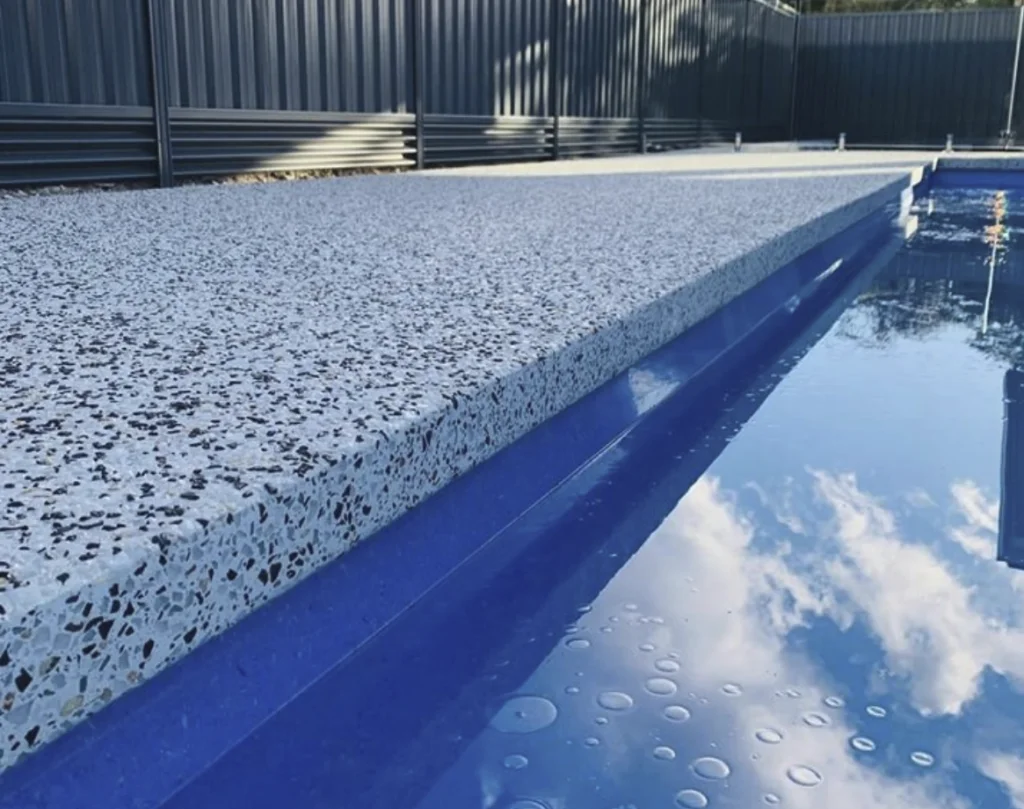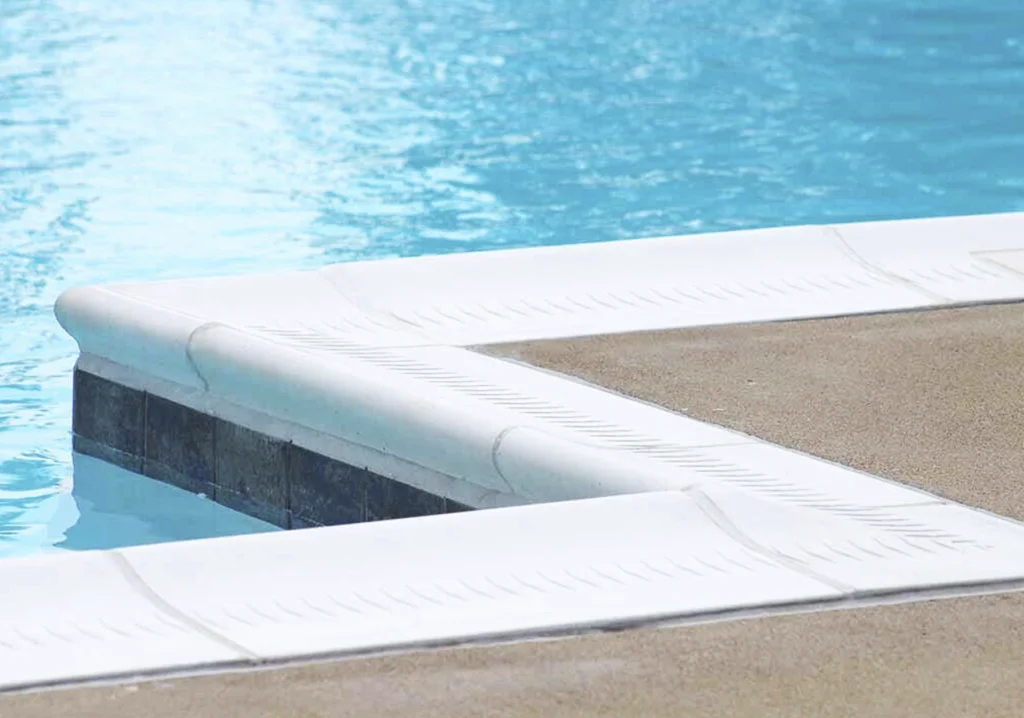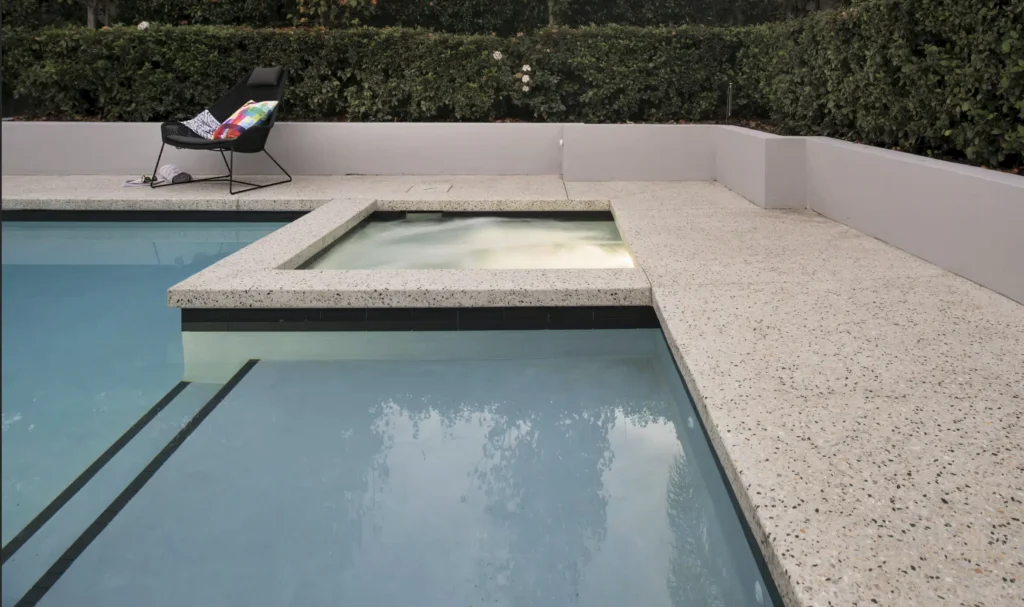When it comes to designing your dream swimming pool, there are so many details to consider. From the size and shape to the finishing touches, each decision impacts the overall look and function of your pool. One crucial element that often gets overlooked is pool edging. Also referred to as pool coping, this is the finishing material that lines the perimeter of the pool, making it as important to the pool’s safety and appearance as the water itself.
But what exactly is pool edging, and why is it essential for a concrete swimming pool? Let’s dive into the details.
What Is Pool Edging?

Pool edging, also called pool coping, refers to the material used to cap the walls of the pool, giving the pool a finished look and protecting the structure. It’s essentially the crowning piece that separates the pool from the surrounding deck or landscape, and it plays a vital role in maintaining the pool’s overall integrity.
When you sit on the edge of a pool or grab onto the pool’s edge while swimming, you’re touching the pool coping. This border is more than just a visual enhancement – it’s a key structural element.
The Importance of Pool Edging
Without pool edging, your pool would be incomplete. Its primary purpose is to protect the pool walls from water and debris, but it does much more. Pool edging ensures that water flows away from the pool and into the proper drainage channels, preventing damage to the pool shell.
Additionally, it prevents water from seeping behind the pool’s shell, which could cause long-term structural damage. By acting as a protective layer, it keeps your pool in optimal condition for years to come.
Pool Edging vs. Pool Coping: What’s the Difference?

While some may use the terms pool edging and pool coping interchangeably, they technically refer to the same thing. The key function remains the same: protecting the pool’s shell and providing a decorative and practical boundary.
How Pool Edging Protects Your Pool
Correct pool edge installation is crucial. The edging covers the bond beam, which is the horizontal structure at the top of the pool wall. This beam adds strength to the pool and is usually made of concrete and steel. Pool edging conceals the structural materials and keeps water from flowing behind the pool shell, preventing potential leaks and damage.
Is Pool Edging Necessary for All Pools?
For in-ground concrete pools, pool edging is a necessity. The pool’s edge needs to be capped with a durable material, ensuring the water flows away from the pool when splashed. Proper installation ensures the edging is slightly tilted to direct water into drainage systems, safeguarding the structure.
Materials Used for Pool Edging
Choosing the right material for your pool edging is essential for both aesthetics and durability. Let’s explore some popular options:
Precast Concrete
Precast concrete is a cost-effective choice. It offers various textures, colors, and patterns, allowing you to customize the look of your pool without breaking the bank. Precast concrete is easy to install and provides a uniform finish.

Natural Stone
For those who prefer a more natural look, natural stone like limestone, granite, or fieldstone is an excellent option. While natural stone is more expensive and challenging to install, it offers a warm and rustic appearance that adds character to any pool.
Brick and Pavers
Brick coping, also known as paver coping, provides a traditional and timeless look. These materials are highly durable and can be tailored to fit different designs, offering both functionality and style.
Popular Pool Edging Styles
Once you’ve selected your material, it’s time to choose the edging style that best complements your pool. Here are a few popular styles:
Bullnose Edging
Bullnose edging is known for its smooth, rounded edges, making it comfortable for swimmers to climb in and out of the pool.
Square Edge
For a sleek and modern look, a square edge gives the pool a sharp, clean finish.
Rebated Square Edge
This style offers a floating look by extending over the pool’s edge. It’s a popular choice in contemporary pool designs.
Exposed Aggregate
This edging style adds texture and enhances grip, providing a non-slip surface ideal for wet areas.
Choosing the Right Pool Edging for Your Pool

When choosing pool edging, consider the design of your entire backyard, not just the pool. The edging should blend seamlessly with other features like decking, landscape, and architecture. It’s also important to select a material that can withstand your pool’s environment, including saltwater or chemicals.
Benefits of Pool Edging
Aesthetic Appeal
Pool edging enhances the visual appeal of your swimming pool, giving it a finished, polished look.
Safety and Functionality
Apart from being visually appealing, pool edging provides a safe, non-slip surface that prevents accidents around the pool.
Non-Slip Surface: A Key Benefit
The last thing you want around a pool is a slippery surface. Properly installed pool edging provides a textured, non-slip area that allows swimmers to safely walk along the pool’s edge.
Pool Edging Installation Process
During installation, the pool edging is placed on the bond beam, securing the edges of the pool. A professional installer ensures that the coping is angled correctly to direct water away from the pool, preventing water damage.
How to Maintain Pool Edging
To keep your pool edging in top condition, clean it regularly and inspect it for cracks or wear. Proper maintenance ensures that your pool remains safe and visually appealing.
Alternative Options to Pool Edging
If you prefer a different look, consider extending the pool deck to cover the pool’s edge, creating a seamless transition. While this offers a sleek appearance, it doesn’t provide the same protection as traditional pool edging.
Conclusion
Pool edging is an essential part of any in-ground concrete pool. It not only protects the pool structure but also enhances its appearance. By choosing the right material and style, you can create a beautiful and functional pool that stands the test of time.
FAQs
What is the best material for pool edging?
Precast concrete is a popular choice due to its affordability and variety of textures. Natural stone offers a more rustic look but can be more expensive.
Is pool edging necessary?
Yes, especially for in-ground pools, pool edging helps protect the pool’s structure and provides a safe, non-slip surface.
Can I install pool edging myself?
While some may attempt DIY
How often should I maintain my pool edging?
Regular cleaning and inspections can keep your pool edging in good condition. Check for cracks or wear at least once a year.
What alternatives are there to pool edging?
Extending the pool deck over the edge of the pool is a common alternative, though it doesn’t provide the same protection as traditional edging.
